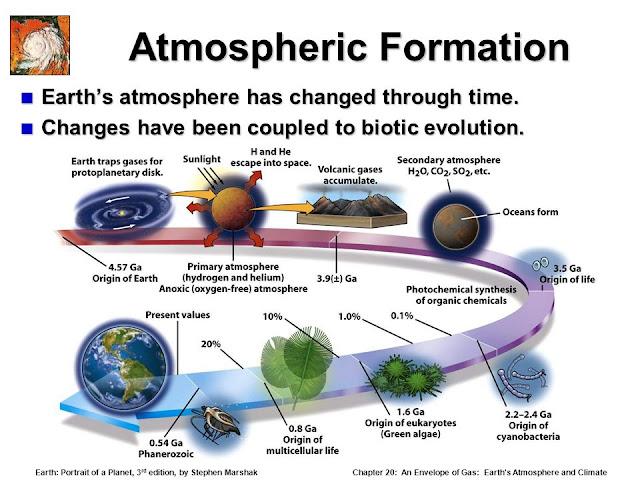Atmosphere
Initially the Earth was in volatile state i.e high temperature and materials were in molten state. The 1st atmosphere of earth was thin layer of hydrogen and helium. Another volatile state material hit the earth during this state, which led to the formation of our moon. Due to this collision the temperature of earth increase more and the molten material which was more denser moved towards the center of earth and lighter material moved towards the surface of earth. This resulted in water vapor and gases being released to the surface. The gases accumulated around the surface and formed 2nd atmosphere.
Oceans
This atmosphere mostly consist of water vapor and gases like CO2 . The atmosphere didn't consist of Oxygen, methane, ammonia etc. The water vapor in atmosphere led to condensation and resulted in rainfall for very long period, this accumulated water on relatively solidified surface and also created oceans on depressed surface. The rain also helped gases to settle down and brought down the dissolved material from the gases towards the oceans.
Oceans were formed 4 billion years ago. Evolution of life was observed 3.8 billion years ago. Evolution of life was in form of bacterial level or microscopic level. Photosynthesis started around 3 to 2.5 billion years ago due to presence of CO2 and sunlight. Due to photosynthesis, Oxygen started releasing and Ocean started saturating with oxygen. This was followed by oxygen moving to the atmosphere which further resulted in 3rd atmosphere which was rich in oxygen and resulted in life evolution.
Earth crust
Initial volatile layer of earth which was in molten state. This layer slowly stated cooling due to density differentiation i.e lighter material from inside the earth came up towards the surface and heavier material went down towards the center of the earth. This process is called Degassing, in which when lighter material came towards the surface released gaseous vapors. Initial solid top layer formed was called oceanic crust over which oceans were formed. This oceanic crust was slightly heavier and further sank and melted again and more lighter material came up and formed a solid top layer called as Continental crust or continental nuclei. The crust started spreading as more material was coming up from center of earth and accumulating with continental crust. Over a period it grew and due to erosion they spread and new material came up and reorganized as present day continents.







0 Comments